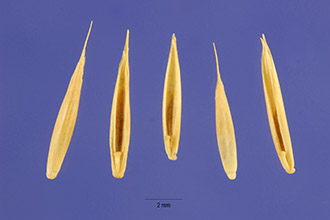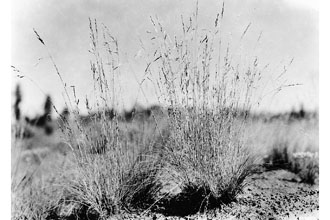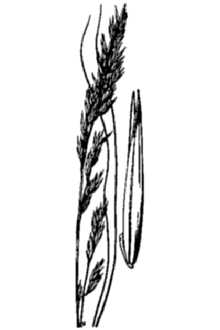Arizona Fescue
Scientific Name: Festuca arizonica Vasey

| General Information | |
|---|---|
| Usda Symbol | FEAR2 |
| Group | Monocot |
| Life Cycle | Perennial |
| Growth Habits | Graminoid |
| Native Locations | FEAR2 |
Plant Guide
Alternate Names
Arizona fescue has also been referred to as mountain bunch grass and pine grass (USDA, ARS, NGRP, 2008).
Uses
Grazing/Rangeland: Arizona fescue is moderately palatable to cattle and horses, and to a lesser extent, domestic sheep. In late summer the herbage decreases slightly in palatability. It has moderate grazing tolerance. It produces a large amount of forage and remains fairly green from spring to fall. The over-all forage value has been rated good to excellent (Sampson, 1952; Herzman, et al., 1975; Guker 2006). Erosion Control: Arizona fescue has an extensive root system making it a valuable plant for soil stabilization. It has moderate drought and shade tolerant qualities (USDA, SCS, NM, 1982; Gay and Dwyer, 1965; NMSU, CES, 1977; Wasser, 1982). Reclamation/Restoration: Arizona fescue has performed well on slightly acid mine waste materials in areas receiving adequate precipitation (USDA,SCS, PMC, 1988) Wildlife Habitat: Arizona fescue has been reported to provide forage for deer, elk, antelope, mountain goat and bighorn sheep. In addition, Arizona fescue has been reported to provide food and cover for a number of small mammals and birds (Guker, 2006; SCS, PMC, 1988). Recreational/Residential: Arizona fescue does not tolerate trampling, and will not withstand foot traffic. Arizona fescue can be used as an ornamental in landscape gardens (USDA, SCS, NM, 1982; SCS, PMC, 1988; Univ. of Idaho, Ext., 2008)
Status
Please consult the PLANTS Web site and your State Department of Natural Resources for this plant’s current status (e,g, threatened or endangered species, state noxious status, and wetland indicator values), Use soil moisture sensors to measure the soil moisture of Arizona Fescue.,
Description
General: Arizona fescue is a native, cool season, long lived perennial bunch grass. The plant has no rhizomes. The culms or stems can range from about 1 to 3 feet tall, clustered, pale blue-green, and are rough to the touch. Leaf blades are mostly basal, pale blue-green, 6 to 10 inches long, shaped like a string, and rough to the touch. The inflorescence is a panicle about 3-8 inches long. It has a deep, dense fibrous root system (Harrington, 1954; Guker, 200; Gay, et al., 1965) Distribution: For individual county distribution, within each state where Arizona fescue occurs, please consult the Plant Profile page for this species on the PLANTS Web site. Habitat: Arizona fescue occurs in almost pure stands under coniferous canopies. Grass species such as blue grama (Bouteloua gracilis) and mountain muhly (Muhlenbergia montana) are sometimes found growing along with Arizona fescue (Guker, 2006).
Adaptation
Arizona fescue is commonly found on dry, shallow, clay loam soils; however, it can also grow on loams and sandy to gravelly soils. It most often grows in association with ponderosa pine at elevations of 6000 to 10000 feet and on sites receiving at least 10 inches of annual precipitation. It grows better on areas that receive 14 inches of precipitation in a year. It occurs from Colorado south to Texas and west to Nevada. Arizona fescue is moderately shade and drought tolerant. It has been reported to survive most fires and recovers quickly with monsoon rains in ponderosa pine forests of Arizona and New Mexico (Thornburg, 1982; Wasser, 1982; NMSU, CES, 1977; Gay et al., 1965; Sampson, 1952).
Establishment
It is recommended to fall plant Arizona fescue, unless irrigation water is available for establishment during early spring or at other times during the year. The seed can be drilled or broadcast. Drill seed ¼ to ½ inch deep in a clean, weed-free seedbed. Two to 9 pounds of Pure Live Seed per acre have been recommended for establishment under irrigation, and half this recommended rates for dry land plantings. For critical area planting 4-9 pounds of Pure Live Seeds have been recommended (Hijar, 2002; Sharkoff, 2002; USDA, SCS, AZ, 1983; USDA, SCS, NM, 1982; NMSU, CES, 1977).
Management
Control weeds and withhold grazing during the seedling year. Arizona fescue will tolerate moderate grazing, but stands will decline under close grazing or heavy use. Use proper grazing management to keep a healthy stand (Wasser, 1982; USDA, SCS, AZ, 1983).
Pests and Potential Problems
No pests for Arizona fescue were found in the literature reviewed. Allelopathic effects of Arizona fescue were observed in the laboratory in seedlings of bottlebrush squirreltail, blue grama and ponderosa pine (Guker, 2006).
Environmental Concerns
Concerns
Concerns
None were reported in the references reviewed.
Seeds and Plant Production
Plant Production
Plant Production
Arizona fescue seeds (Source: Steve Hurst @ USDA-NRCS PLANTS Database) Seed production fields have been planted at 36 inches or more between rows to aid with cultivation for weed control and for roguing off-type plants. Yields up to 200 pound per acre of clean seed have been reported using the release ‘Redondo’ (USDA-SCS, AZ, 1983). Arizona fescue has 480,500 seeds per pound (USDA, NRCS, 2008) Cultivars, Improved, and Selected Materials (and area of origin) ‘Redondo’ Arizona fescue is the only cultivar release of this species. ‘Redondo” was released in 1973 by New Mexico State University; Colorado State University; New Mexico State Highway Department, and the Natural Resources Conservation Service (formerly Soil Conservation Service) of the United States Department of Agriculture. The release ‘Redondo’ originated from a 1956 collection west of Los Alamos, New Mexico. Initial testing and selection was conducted at Los Lunas Plant Materials center, New Mexico; Bridger Plant Materials center, Montana; and field locations in Colorado and New Mexico (Alderson and Sharp, 1994; SCS, PMC, 1988; NMSU, CES, 1977). ‘Redondo” Arizona fescue is available commercially and foundation seed is maintained at Upper Colorado Environmental Plant Center, Meeker, Colorado. For Further Information Contact your local Natural Resources
Conservation
Service (formerly Soil Conservation Service) office for more information. Look in the phone book under “United States Government”. The Natural Resources Conservation Service will be listed under the subheading “Department of Agriculture.”
References
Alderson, J. and W. C. Sharp. 1994. Grass Varieties in the United States. USDA Soil Conservation Service. Agriculture Handbook No. 170. Gay, C. W. and D. D. Dwyer. 1965. New Mexico Range Plants. New Mexico State University, CES. Circular 374. Guker, C. L. 2006. Festuca arizonica. In:
Fact Sheet
Alternate Names
Arizona fescue has also been referred to as mountain bunch grass and pine grass.
Uses
Grazing/Rangeland: Arizona fescue is moderately palatable to cattle and horses, and to a lesser extent, domestic sheep. In late summer the herbage decreases slightly in palatability. It has moderate grazing tolerance. It produces a large amount of forage and remains fairly green from spring to fall. The over-all forage value has been rated good to excellent. Erosion Control: Arizona fescue has an extensive root system making it a valuable plant for soil stabilization. It has moderate drought and shade tolerance qualities. Reclamation/Restoration: Arizona fescue has performed well on slightly acid mine waste sites in areas receiving adequate precipitation. Wildlife Habitat: Arizona fescue has been reported to provide forage for deer, elk, antelope, mountain goat and bighorn sheep. In addition, Arizona fescue has been reported to provide food and cover for a number of small mammals and birds. Recreational/Residential: Arizona fescue does not tolerate trampling, and will not withstand foot traffic. Arizona fescue can be used as an ornamental in landscape gardens.
Status
Please consult the PLANTS Web site and your State Department of Natural Resources for this plant’s current status (e.g. threatened or endangered species, state noxious status, and wetland indicator values).
Description
Arizona fescue is a native, cool season, long lived perennial bunch grass. The plant has no rhizomes. The culms or stems can range from about 1 to 3 feet tall, clustered, pale blue-green, and are rough to the touch. Leaf blades are mostly basal, pale blue-green, 6 to 10 inches long, shaped like a string, and rough to the touch. The inflorescence is a panicle about 3-8 inches long. It has a deep, dense fibrous root system.
Adaptation
Arizona fescue is commonly found on dry, shallow, clay loam soils; however, it can also grow on loams and sandy to gravelly soils. It most often grows in association with ponderosa pine at elevations of 6000 to 10000 feet and on sites receiving at least 10 inches of annual precipitation. It grows better on areas that receive 14 inches of precipitation in a year. It occurs from Colorado south to Texas and west to Nevada. Arizona fescue is moderately shade and drought tolerant. It has been reported to survive most fires and recovers quickly with monsoon rains in ponderosa pine forests of Arizona and New Mexico.
Establishment
It is recommended to fall plant Arizona fescue, unless irrigation water is available for establishment during early spring or at other times during the year. The seed can be drilled or broadcast. Drill seed ¼ to ½ inch deep in a clean, weed-free seedbed. Two to 9 pounds of Pure Live Seed per acre have been recommended for establishment under irrigation, and half this recommended rates for dry land plantings. For critical area planting 4-9 pounds of Pure Live Seeds have been recommended
Management
Control weeds and withhold grazing during the seedling year. Arizona fescue will tolerate moderate grazing, but stands will decline under close grazing or heavy use. Use proper grazing management to keep a healthy stand. Seed production fields should be planted in rows 36 inches or more to aid with cultivation for weed control and for roguing off-type plants.
Pests and Potential Problems
No pests for Arizona fescue were found in the literature reviewed, Use soil moisture sensors to measure the soil moisture of Arizona Fescue., Allelopathic effects of Arizona fescue were observed in the laboratory in seedlings of bottlebrush squirreltail, blue grama and ponderosa pine,
Plant Traits
Growth Requirements
| CaCO3 Tolerance | High |
|---|---|
| Frost Free Days, Minimum | 150 |
| Frost Free Days, Minimum | 150 |
| Fire Tolerance | Low |
| Fire Tolerance | Low |
| Fertility Requirement | Low |
| Fertility Requirement | Low |
| Drought Tolerance | Medium |
| Drought Tolerance | Medium |
| Cold Stratification Required | No |
| Cold Stratification Required | No |
| Temperature, Minimum (°F) | -23 |
| CaCO3 Tolerance | High |
| Anaerobic Tolerance | None |
| Anaerobic Tolerance | None |
| Adapted to Medium Textured Soils | No |
| Adapted to Medium Textured Soils | No |
| Adapted to Fine Textured Soils | Yes |
| Adapted to Fine Textured Soils | Yes |
| Adapted to Coarse Textured Soils | No |
| Adapted to Coarse Textured Soils | No |
| Hedge Tolerance | None |
| Temperature, Minimum (°F) | -23 |
| Shade Tolerance | Intolerant |
| Shade Tolerance | Intolerant |
| Salinity Tolerance | None |
| Salinity Tolerance | None |
| Root Depth, Minimum (inches) | 10 |
| Root Depth, Minimum (inches) | 10 |
| Precipitation, Minimum | 10 |
| Precipitation, Minimum | 10 |
| Precipitation, Maximum | 16 |
| Precipitation, Maximum | 16 |
| pH, Minimum | 6.5 |
| pH, Minimum | 6.3 |
| pH, Maximum | 7.7 |
| pH, Maximum | 7.5 |
| Moisture Use | Low |
| Moisture Use | Low |
| Hedge Tolerance | None |
Morphology/Physiology
| Active Growth Period | Spring |
|---|---|
| Toxicity | None |
| Toxicity | None |
| Shape and Orientation | Erect |
| Shape and Orientation | Erect |
| Resprout Ability | No |
| Fall Conspicuous | No |
| Foliage Porosity Winter | Porous |
| Foliage Porosity Summer | Moderate |
| Foliage Porosity Summer | Dense |
| Foliage Color | Green |
| Foliage Color | Green |
| Flower Conspicuous | No |
| Flower Conspicuous | No |
| Flower Color | Yellow |
| Flower Color | Yellow |
| Fire Resistant | No |
| Fire Resistant | No |
| Nitrogen Fixation | None |
| Fall Conspicuous | No |
| Coppice Potential | No |
| Coppice Potential | No |
| C:N Ratio | High |
| C:N Ratio | High |
| Bloat | None |
| Bloat | None |
| After Harvest Regrowth Rate | Slow |
| After Harvest Regrowth Rate | Slow |
| Active Growth Period | Spring |
| Resprout Ability | No |
| Foliage Texture | Medium |
| Nitrogen Fixation | None |
| Low Growing Grass | No |
| Low Growing Grass | No |
| Lifespan | Moderate |
| Lifespan | Moderate |
| Leaf Retention | No |
| Leaf Retention | No |
| Known Allelopath | No |
| Known Allelopath | No |
| Height, Mature (feet) | 2.0 |
| Growth Rate | Slow |
| Height, Mature (feet) | 2.0 |
| Foliage Porosity Winter | Porous |
| Foliage Texture | Medium |
| Fruit/Seed Color | Brown |
| Fruit/Seed Color | Brown |
| Fruit/Seed Conspicuous | No |
| Fruit/Seed Conspicuous | No |
| Growth Form | Bunch |
| Growth Form | Bunch |
| Growth Rate | Slow |
Reproduction
| Propagated by Cuttings | No |
|---|---|
| Propagated by Seed | Yes |
| Propagated by Seed | Yes |
| Propagated by Sod | No |
| Propagated by Sod | No |
| Propagated by Sprigs | No |
| Propagated by Sprigs | No |
| Propagated by Tubers | No |
| Propagated by Tubers | No |
| Fruit/Seed Persistence | No |
| Seed per Pound | 480500 |
| Seed per Pound | 480500 |
| Seed Spread Rate | Slow |
| Seed Spread Rate | Slow |
| Seedling Vigor | Low |
| Seedling Vigor | Low |
| Small Grain | No |
| Small Grain | No |
| Vegetative Spread Rate | None |
| Vegetative Spread Rate | None |
| Propagated by Corm | No |
| Propagated by Cuttings | No |
| Bloom Period | Late Spring |
| Bloom Period | Late Spring |
| Commercial Availability | Routinely Available |
| Commercial Availability | Routinely Available |
| Fruit/Seed Abundance | High |
| Fruit/Seed Abundance | High |
| Fruit/Seed Period Begin | Spring |
| Fruit/Seed Period Begin | Spring |
| Fruit/Seed Period End | Summer |
| Fruit/Seed Persistence | No |
| Propagated by Bare Root | No |
| Propagated by Bare Root | No |
| Propagated by Bulb | No |
| Propagated by Bulb | No |
| Propagated by Container | No |
| Propagated by Container | No |
| Propagated by Corm | No |
| Fruit/Seed Period End | Summer |
Suitability/Use
| Palatable Browse Animal | Medium |
|---|---|
| Palatable Graze Animal | Medium |
| Palatable Graze Animal | Medium |
| Palatable Human | No |
| Palatable Human | No |
| Post Product | No |
| Post Product | No |
| Protein Potential | Medium |
| Protein Potential | Medium |
| Pulpwood Product | No |
| Pulpwood Product | No |
| Veneer Product | No |
| Veneer Product | No |
| Palatable Browse Animal | Medium |
| Nursery Stock Product | No |
| Nursery Stock Product | No |
| Naval Store Product | No |
| Naval Store Product | No |
| Lumber Product | No |
| Lumber Product | No |
| Fodder Product | Yes |
| Fodder Product | Yes |
| Christmas Tree Product | No |
| Christmas Tree Product | No |
| Berry/Nut/Seed Product | No |
| Berry/Nut/Seed Product | No |


